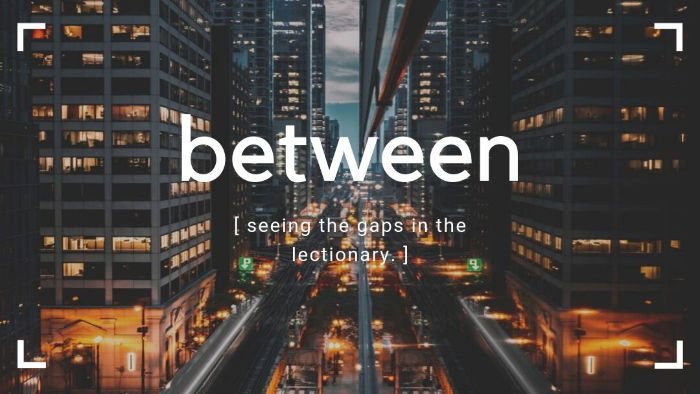A look at the gaps in the lectionary.
This week: the gap between Easter 7A + Pentecost
The text: John 17:12-20:18 or 7:36
This week, we get a choice. John 20:19-23 or 7:37-39.
Both are short. And we did a reading from John 20 back in Easter 2. So, if you’re needing some help deciding on which one to go with this week, the choice is between repetition and newness.
Either way, the preacher’s probably talking about Acts and the Pentecost Event more than Jesus presaging a Holy Spirit encounter.
Of course, these “between” posts are not about the text we’re reading, but the gaps in the lectionary, so let’s dig into the context of these two readings.
John 20:19-23
Between the time Jesus prays in John 17 and the encounter in John 20 is the Passion. And not a lot else. The prayer we began for Easter 7 actually continues through the rest of chapter 17. Then 18 begins with the trip to the garden, the betrayal, and arrest. We go through the whole Passion narrative. Then the resurrection. And then he appears to them.
John 7:37-39
This passage is far more interesting to me. Mostly because this part of John feels overlooked. It doesn’t really function within the birth > miracles > Passion > Crucifixion > Resurrection > Ascension thematic sequence. It gets sorted into the “stuff Jesus does while teaching” part of our focus.
It could also be that John functions for us as the grand teller of specific stories. So we use him for the Woman at the Well and the Wedding at Cana. And we also use him for Holy Week. But otherwise, the rest is Synoptics.
This is all to say that the sequence here has been quite illuminating for me this year, as we have spent a lot of time in the middle of John on Sunday, but all of it is decontextualized. We’re focusing on his talking about the future, and not about what he is experiencing.
The big threat
If we back up a chapter, we get the miracle that appears in all four gospels: the feeding of the multitudes.
What happens next is important.
Jesus confronts those multitudes in what seems like a “true believer” test. Something, at first glance, comes off as snotty more than earnest. Jesus questions the veracity of the multitudes. He suggests that their motives are selfish rather than altruistic. Do they follow for the miracles or the purpose? Do they want to be close to power or to make the Kin-dom come?
While theobros take offense and those obsessed with modernism or literalism freak out, the point Jesus is making is far more troubling to our own conscience than either group will admit.
Jesus is threatening the very idea of cultural Christianity. Of being a part of something tangentially or for any purpose short of true discipleship.
In other words, Jesus threatens the very character of modern Christianity itself.
And he was challenging their own sense of religion. So people take off. They stop following him.
And some plot to kill him.
This is no joke. They actively seek ways to kill him.
What this does to the narrative is spur on several chapters of intense confrontation. Primarily between Jesus and the Temple leadership. But sometimes it is punctuated by other devisions. Such as when Mary/Martha seeks to have Jesus save Lazarus.
The immediate context, however, is a trip to Jerusalem for the Festival of the Booths. There, some continue the plot and some argue over him.
And in the midst of this, Jesus begins to teach at the Temple. This causes awe and wondering: is this the Christ? Is it possible? It also spurs, unsurprisingly, more condemnation. To the point that some seek to arrest him.
This is the weird part that immediately precedes the reading.
They go to arrest Jesus and he says
‘I will be with you a little while longer, and then I am going to him who sent me. You will search for me, but you will not find me; and where I am, you cannot come.’
—John 7:33-34
This seems to confuse them enough that they don’t arrest him? OK…
Then he speaks about the spirit.
And this goes over…like everything else before it. The people who think he might be the Christ are like Yeah, OK! and the people who don’t are like WTF?
What to preach on
The Pentecost, obviously. And, of the two decontextualized, John 20:19-23 is easier to work with.
But I generally don’t prefer easy or decontextualized. I prefer going into context and helping reveal the wisdom of the bigger picture. So I’m leaning toward John 7:37-39 this week with the context as the meat of it.
How?
Probably leading off with the basic question of Why then are we divided?
The Pentecost raises the basic question of division. After two thousand years, shouldn’t we be on the same page yet? Shouldn’t the Kin-dom be here by now?
All the questions raised by the Pentecost reveal the truth of our agency. The reliance of the Holy Spirit on us receiving her into us. On our being part of the divine project.
I suspect this is all necessary. Always necessary to talk about. And John 7 gives us a way in.
Because division is the natural course for John.
While our focus is always on unity and finding unity like a lost puppy, Jesus is busy finding the KIn-dom. He even seems to be doing this in spite of our obsession with unity. Because we are making unity our all-or-nothing rather than the Kin-dom itself.
The Pentecost Event, full of it’s Spirit-given human agency through divine partnership, is a perfect time to speak to this. To name our own obsessions. And ultimately, to speak to the true challenge of generous agency: that some will always say no.
But we, no matter how reluctantly, are called to say yes.
